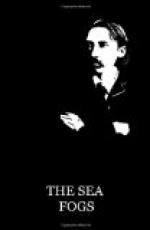Title: The Sea Fogs
Author: Robert Louis Stevenson
Release Date: March, 2004 [EBook #5272] [Yes, we are more than one year ahead of schedule] [This file was first posted on June 23, 2002]
Edition: 10
Language: English
Character set encoding: ASCII
*** Start of the project gutenberg EBOOK, the sea fogs ***
This eBook was produced by David Schwan davidsch@earthlink.net.
Western Classics No. 1
The Sea Fogs
A sheeted spectre white and tall,
The cold mist climbs the castle wall
And lays its hand upon thy cheek.
Longfellow.
The Sea Fogs
By Robert Louis Stevenson
with an Introduction by Thomas Rutherford Bacon
The Photogravure Frontispiece after a Painting
by Albertine Randall Wheelan
Introduction
Robert Louis Stevenson first came to California in 1879 for the purpose of getting married. The things that delayed his marriage are sufficiently set forth in his “Letters” (edited by Sidney Colvin) and in his “Life” (written by Graham Balfour). It is here necessary to refer only to the last of the obstacles, the breaking down of his health. It is in connection with the evil thing that came to him at this time that be first makes mention of “the sea fogs,” that beset a large part of the California coast. He speaks of them as poisonous; and poisonous they are to any one who is afflicted with pulmonary weakness, but bracing and glorious to others. They give the charm of climate to dwellers around the great bay. How he took this first very serious attack of the terrible malady is indicated in the letter to Edmund Gosse, dated April 16, 1880. His attitude toward death is shown here, and is further shown in his little paper AEs Triplex, in which he successfully vindicates his generation from the charge of cowardice in the face of death. Stevenson’s two distinguishing characteristics were his courage and his determination to be happy as the right way of making other people happy. His courage, far more than change of scene and climate, gave him fourteen more years in which to contribute to the sweetness and light of the world. These years were made fruitful to others by his determined happiness, a happiness in which the main factor, outside of his own determination, came from the companionship which his marriage brought to him. The great principles by which he lived influenced those who did not know him personally, through his gift of writing. He always maintained that it was not a gift but an achievement, and that any one could write as well as he by taking as much pains. We may well doubt the soundness of this theory, but we cannot doubt the spiritual attitude from which it came. It came from no mock humility, but from a feeling that nothing was creditable to him except what he did. He asked no credit for the talents committed to his charge He asked credit only for the use be made of the talents.




